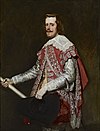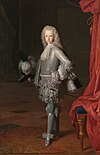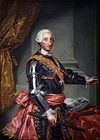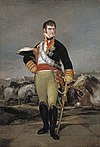
The Viceroyalty of New Granada also called Viceroyalty of the New Kingdom of Granada or Viceroyalty of Santafé was the name given on 27 May 1717 to the jurisdiction of the Spanish Empire in northern South America, corresponding to modern Colombia, Ecuador, Panama and Venezuela. Created in 1717 by King Felipe V, as part of a new territorial control policy, it was suspended in 1723 for financial problems and was restored in 1739 until the independence movement suspended it again in 1810. The territory corresponding to Panama was incorporated later in 1739, and the provinces of Venezuela were separated from the Viceroyalty and assigned to the Captaincy General of Venezuela in 1777. In addition to those core areas, the territory of the Viceroyalty of New Granada included Guyana, Trinidad and Tobago, southwestern Suriname, parts of northwestern Brazil, and northern Peru.

A viceroy is an official who reigns over a polity in the name of and as the representative of the monarch of the territory.

Upper Peru is a name for the land that was governed by the Real Audiencia of Charcas. The name originated in Buenos Aires towards the end of the 18th century after the Audiencia of Charcas was transferred from the Viceroyalty of Peru to the Viceroyalty of the Río de la Plata in 1776. It comprised the governorships of Potosí, La Paz, Cochabamba, Chiquitos, Moxos and Charcas.

The Viceroyalty of Peru, officially known as the Kingdom of Peru, was a Spanish imperial provincial administrative district, created in 1542, that originally contained modern-day Peru and most of the Spanish Empire in South America, governed from the capital of Lima. Peru was one of the two Spanish viceroyalties in the Americas from the sixteenth to the eighteenth centuries.

The Argentine War of Independence was a secessionist civil war fought from 1810 to 1818 by Argentine patriotic forces under Manuel Belgrano, Juan José Castelli, and José de San Martín against royalist forces loyal to the Spanish crown. On 9 July 1816, an assembly met in San Miguel de Tucumán, declaring independence with provisions for a national constitution.

The Viceroyalty of the Río de la Plata meaning "River of the Silver", also called "Viceroyalty of the River Plate" in some scholarly writings, in southern South America, was the last to be organized and also the shortest-lived of the Viceroyalties of the Spanish Empire in the Americas. The name "Provincias del Río de la Plata" was formally adopted in 1810 during the Cortes of Cádiz to designate the Viceroyalty of the Río de la Plata.
In the context of the Spanish Empire, a peninsular was a Spaniard born in Spain residing in the New World, Spanish East Indies, or Spanish Guinea. Nowadays, the word peninsulares makes reference to Peninsular Spain and in contrast to the "islanders" (isleños), from the Balearic Islands, the Canary Islands or the territories of Ceuta and Melilla.

Francisco Álvarez de Toledo, also known as The Viceroyal Solon, was an aristocrat and soldier of the Kingdom of Spain and the fifth Viceroy of Peru. Often regarded as the "best of Peru's viceroys", he is as often denounced for the negative impact his administration had on the Indigenous peoples of Peru.

The Peruvian War of Independence was a series of military conflicts in Peru from 1809 to 1826 that resulted in the country's independence from the Spanish Empire. Part of the broader Spanish American wars of independence, it led to the dissolution of the Spanish Viceroyalty of Peru.

José Antonio de Mendoza Caamaño y Sotomayor, 3rd Marquis of Villagarcía de Arousa was a Spanish colonial administrator in the Americas. From 4 February 1736 to 15 December 1745 he was Viceroy of Peru.

Juan Pío Camilo de Tristán y Moscoso was a Peruvian general and politician who served as the second President of South Peru from October 12, 1838 to February 23, 1839. He was nominally the last viceroy of Peru, serving in that capacity from December 9 to December 30, 1824, but not exercising power.

The Laws of the Indies are the entire body of laws issued by the Spanish Crown for the American and the Asian possessions of its empire. They regulated social, political, religious, and economic life in these areas. The laws are composed of myriad decrees issued over the centuries and the important laws of the 16th century, which attempted to regulate the interactions between the settlers and natives, such as the Laws of Burgos (1512) and the New Laws (1542). Throughout the 400 years of Spanish presence in these parts of the world, the laws were compiled several times, most notably in 1680 under Charles II in the Recopilación de las Leyes de los Reynos de las Indias. This became considered the classic collection of the laws, although later laws superseded parts of it, and other compilations were issued.

The Real Audiencia of Quito was an administrative unit in the Spanish Empire which had political, military, and religious jurisdiction over territories that today include Ecuador, parts of northern Peru, parts of southern Colombia and parts of northern Brazil. It was created by Royal Decree on 29 August 1563 by Philip II of Spain in the city of Guadalajara. It ended in 1822 with the incorporation of the area into the Republic of Gran Colombia.

The history of Lima, the capital of Peru, began with its foundation by Francisco Pizarro on January 18, 1535. The city was established on the valley of the Rímac River in an area populated by the Ichma polity. It became the capital of the Viceroyalty of Peru and site of a Real Audiencia in 1543. In the 17th century, the city prospered as the center of an extensive trade network despite damage from earthquakes and the threat of pirates. However, prosperity came to an end in the 18th century due to an economic downturn and the Bourbon Reforms.

Juan José de Vértiz y Salcedo was a Spanish colonial politician born in New Spain, and Viceroy of the Río de la Plata.
After sending away royal appointed governor of the Viceroyalty of Peru, Blasco Núñez Vela and later defeating and killing him in the battle of Añaquito, Gonzalo Pizarro assembled an army of 1,200 men to press claims for the rule over Peru, once belonging to him and his brothers. The new viceroy, Pedro de la Gasca, landed in Peru in 1547, and a contingent of his troops, led by Diego Centeno, was severely defeated at Huarina by Francisco de Carvajal
The Real Audiencia and Chancery of Lima was a superior court in the New World empire of Spain, located in the city of Lima, capital of the Viceroyalty of Peru. It was created on November 20, 1542 as was the viceroyalty itself, by the Emperor Charles V. The Audiencia began functioning in 1543 and initially had jurisdiction over the entire viceroyalty—virtually all of Spanish-controlled South America and Panama. Later other audiencias were established in the Viceroyalty. The Audiencia functioned until 1821 when the forces of José de San Martín entered Lima.

The Colombian Declaration of Independence occurred on July 20, 1810 when the Junta de Santa Fe was formed in Santa Fe de Bogota, the capital of the Spanish colonial Viceroyalty of New Granada, to govern the territory autonomously from Spain. The event inspired similar independence movements across Latin America, and triggered an almost decade-long rebellion culminating in the founding of the Republic of Gran Colombia, which spanned present-day Colombia, mainland Ecuador, Panama, and Venezuela, along with parts of northern Peru and northwestern Brazil.

The dissolution of the Viceroyalty of the Río de la Plata meant the breakup of the Spanish colony in South America and the creation of new independent countries. Most of the territory of the Spanish viceroyalty is now part of Argentina, and other regions belong to Bolivia, Brazil, Paraguay and Uruguay.









































































